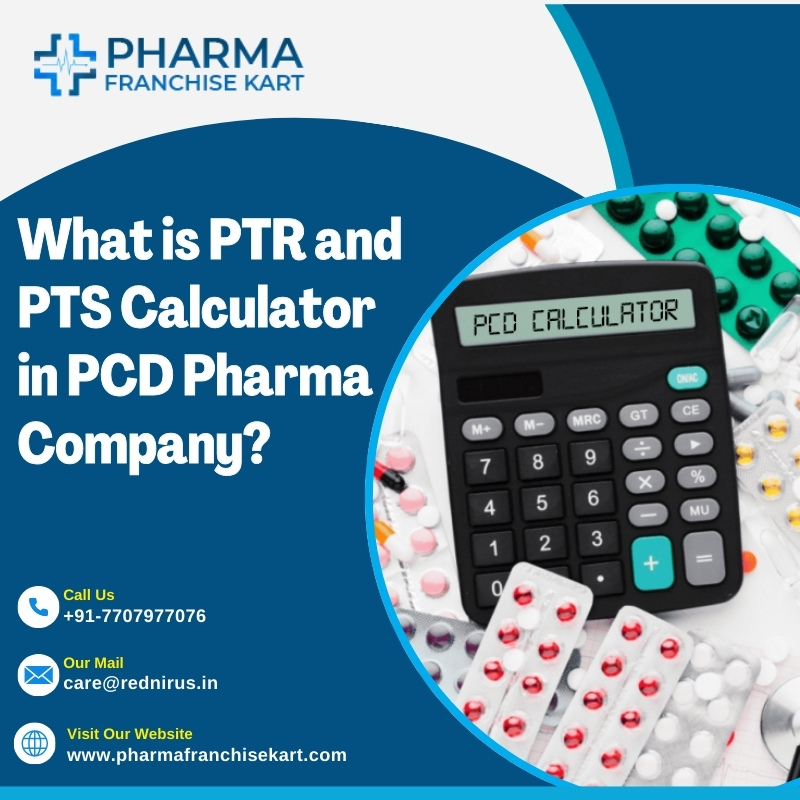In the pharmaceutical distribution industry understanding pricing structures, margins and taxes is crucial for business success. Among these multifarious tools for making all operations streamlined so the profitability stands up, calculators of PTR – or Price to Retailer and PTS- Price to Stockist form a highly integrated part of its calculation mechanism. Let’s dive into the essential concepts of PTR, PTS, GST, MRP and so on to know how they impact the operations of a PCD pharma company.

What is PTR?
PTR is the selling price of the product by the pharma company to the retailer. It is the most important consideration for determining the retail price of pharmaceutical products. PTR is the amount of money a retailer pays to the pharma franchise company to procure that product and is usually found out by adding all concessions a pharma company gives to a retailer to its MRP.
While dealing with distributors in PCD pharma and sometimes third party marketing and distribution also, PTR assures that there exists transparency between pharma companies, distributors and retailers in the field of pricing of pharmaceuticals and helps price streamlining. the use of PTR price calculator can easily check the price given to a commodity by adding variable costs, amount of profit wished, and others.
What is PTS?
Price to Stockist or PTS is the selling price of pharmaceutical companies to stockists or wholesalers in the chain. Stockists deal with the order in large quantities and supply the product to several retailers or a small number of distributors. PTS is comparatively lesser than MRP and PTR since it is the price the stockist purchases from the pharma company for redelivery to the retailers.
The PTS calculator will be used to find the correct pricing for the stockists. Bulk purchase discounts, distribution costs and profit margins are also taken into consideration. In the supply chain, PTS plays a critical role because it provides the foundation of how pharmaceutical products are priced from the manufacturer all the way down to the end customer. By efficiently calculating PTS, PCD pharma companies can have a steady flow of products through their distribution network and manage profitability at different stages of the supply chain.
What is GST?
GST is a value added tax charged on the sale of goods and services in India. In pharmaceutical companies, GST applies not just to medicines but also on product distribution. Therefore, it’s quite essential that PCD pharma companies know about GST, as it affects the price and taxation of every product sold.
There are two major tax slabs for the GST pharma sector: 5% and 18%. The tax rate depends on the nature of the product. For example, life-saving drugs might attract a 5% lower rate, whereas other pharmaceutical products might attract a higher rate of 18%. GST is added to the price of medicines, thus affecting the cost calculation for retailers and stockists. So, in a PCD pharma company, the proper GST calculation needs to be kept in PTR and PTS and also in the total pricing structure for compliance with tax rules.
What is MRP in PCD Pharma?
MRP stands for Maximum Retail Price, which indicates the maximum possible price at which a product will be sold within the market. For PCD pharma companies, MRP is a component of the strategy of pricing as it determines an upper limit based on which consumers will pay for something. Though the selling prices may vary at the time of discounts, this MRP ensures consumers do not spend more than they are supposed to.
The MRP in PCD pharma model is arrived at by incorporating the cost of production, distribution, and the additional profits to be garnered by the distributor and retailer together with the payable taxes such as GST. Many pharmaceutical products usually carry the printed MRP along with the packing. This lets the consumer understand the maximum they are going to pay for any product. Such an approach allows keeping the price a transparent affair for consumers and from overcharging, it saves consumers.
How to Calculate PTR? Formula to Find PTR?
Calculating PTR involves various pricing components, including MRP, stockist discounts, retailer margins, and GST. The formula for finding PTR is as follows:
PTR = MRP – (Discount to Stockist + Stockist Margin + GST)
What is the Retailer Margin in Pharma?
The margin of profit is referred to as retailer margin. It is the margin percentage prepared by retailers to maintain a level of profitability. This is often done by adding a markup percentage to the PTR or selling price at which the retailer will buy the product from the distributor or stockist. Different types of products, market competition, and the agreement between the pharma company and the retailer determine this level of retailer margin.
In the PCD pharma model, the retail margin is taken into consideration to ensure that their willingness to sell a product varies with the type of margin. As the margin has a direct connection with the incentive of retailers and the higher incentives will encourage more retailers to accept the product which will increase their reach in the market. However, the retailer margins have to be weighed against this overall price strategy for the company to remain competitive as it tries to maximize its profits at every stage of the supply chain.
Conclusion
It is very important for a PCD pharma company to understand PTR, PTS, GST, MRP and retailer margins to work smoothly. All these factors are directly linked to pricing strategies, profitability and the entire distribution process. By using tools like PTR and PTS calculators, PCD pharma companies can ensure they are pricing their products effectively, staying compliant with tax regulations and optimizing the margins for stockists and retailers.
You may also like:
Why PCD Pharma Distributors are Backbone of Pharma Industry?

